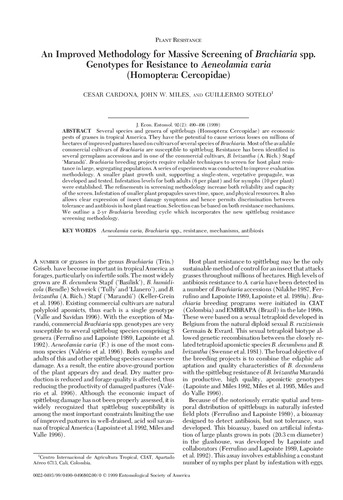An improved methodology for massive screening of Brachiaria spp. genotypes for resistance to Aeneolamia varia (Homoptera: Cercopidae)
Several species and genera of spittlebugs (Homoptera: Cercopidae) are economic pests of grasses in tropical America. They have the potential to cause serious losses on millions of hectares of improved pastures based on cultivars of several species of Brachiaria. Most of the available commercial cultivars of Brachiaria are susceptible to spittlebug. Resistance has been identified in several germplasm accessions and in one of the commercial cultivars, B. brizantha (A. Rich.) Stapf ‘Marandú’. Brachiaria breeding projects require reliable techniques to screen for host plant resistance in large, segregating populations. A series of experiments was conducted to improve evaluation methodology. A smaller plant growth unit, supporting a single-stem, vegetative propagule, was developed and tested. Infestation levels for both adults (6 per plant) and for nymphs (10 per plant) were established. The refinements in screening methodology increase both reliability and capacity of the screen. Infestation of smaller plant propagules saves time, space, and physical resources. It also allows clear expression of insect damage symptoms and hence permits discrimination between tolerance and antibiosis in host plant reaction. Selection can be based on both resistance mechanisms. We outline a 2-yr Brachiaria breeding cycle which incorporates the new spittlebug resistance screening methodology.

